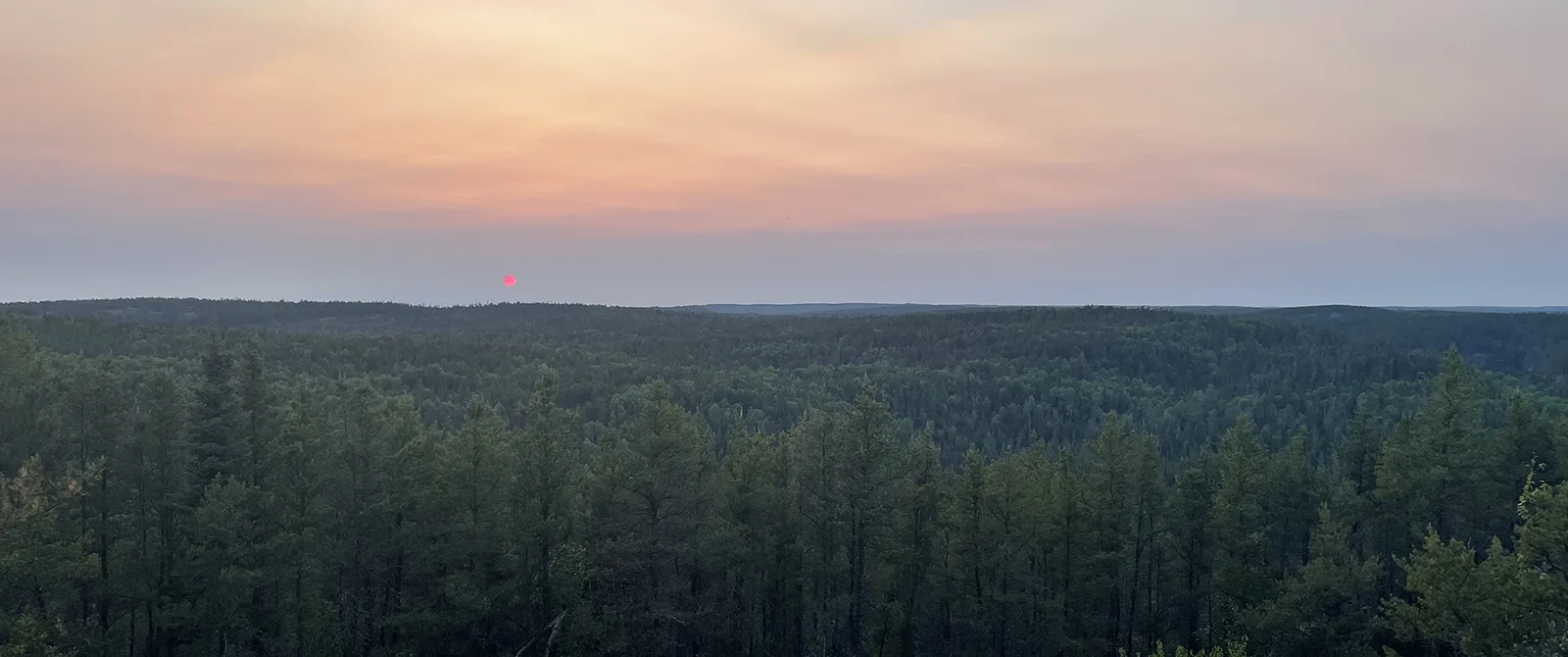Originally published in Lake of the Woods Area News, Volume 55, Number 5, Winter 2025
Tales from a summer student visiting the world’s freshwater laboratory for the very first time.
My journey to the secluded IISD Experimental Lakes Area really began on the infamous Pine Road, the forty-five-minute drive that acts as the entry and exit point to the world’s freshwater laboratory. It was while driving down this winding, scenic road, with tree after tree, lake after lake passing by, that I began to realize how unique an experience I was about to jump into.
As a summer student working in Winnipeg, this was my first time visiting the IISD-ELA, and although the entire week was a whirlwind of new places, people, and memories, there were six things that really grabbed me by surprise.
You’re deeper in the wild than you think
As you travel down Pine Road, approaching camp, you begin to realize just how immersed in the wilderness you are. Access to Highway 17—part of the Trans-Canada Highway that connects the country—is reassuringly close. But it’s far enough away that the hustle and bustle of the city is shielded out by the tranquillity and authenticity of the lakes, forests, and wildlife that IISD-ELA finds itself nestled in.
The warmest of welcomes await you
After pulling into the camp, I was quickly greeted by friendly faces. These friendly faces ended up becoming great friends during my stay at camp, but were also a symbol of the broader welcoming community of people who call IISD-ELA their home, office, or happy place. Scientists, students, and avid canoers alike all enjoy each other’s company. They share meals, memories, and mosquitoes as everyone comes together to create an amazing atmosphere. I came into the camp having been acquainted with merely three people, but left knowing well over thirty, and with a strong sense of belonging.
Your invitation to say “yes” to everything
Much of this amazing sense of community comes down to the vast selection of activities to join in on. Invitations to partake in sunset hikes, kalimba concerts, and volleyball matches all introduced me to many new people at camp, and their special qualities that make it such a fun and vibrant community.
Canoe trips, outdoor fitness equipment, a beach… you name it! It was incredibly easy to find endless ways to enjoy the outdoors and share the fun with my new friends and colleagues. Bonus tip: there’s even a “hot tub” located a small hike away from camp.


Groundbreaking science happens here
For most “campers”, however, there is also groundbreaking research to be completed. At IISD-ELA, scientists, researchers, and students from all across the world come together to conduct scientific experiment—the findings of which go on to inform policy and practices at local, national, and international levels.
During my stay, I was lucky enough to be able to accompany the pELAstics (iisd.org/ela/researchers/our-research/plastics) team as they introduced plastics into a lake to study the fate and impacts of microplastics in a whole-lake ecosystem. Seeing the team in action and helping with the experiment was incredible. The team’s enthusiasm was contagious, and I quickly found myself wishing I had chosen to study some type of natural science at university.
Building relationships with the land and its peoples
Before the pELAstics team began their additions, we each made an offering of tobacco to the lake and said a small prayer. Traditions like these are a small part of how the IISD-ELA fosters strong relationships with Indigenous communities and with the land itself.
After reading the Treaty #3 nibi declaration, making the tobacco offering, and hearing about the Indigenous elders, nations, and communities who work with the camp and inform its practices, it was humbling to pause and reflect on the responsibilities that come with being present in this place. It reminded us of the deep history of these places and of how much we have to learn from those who have stewarded them for generations.
Nature has a way of sticking with you
With this appreciation for, among other things, connection to the land, it became increasingly hard not to feel grateful for the quiet resilience of the forests, waters, and wildlife that surround and sustain us here, reminding us of the care, balance, and responsibility our world depends on. Looking back, IISD-ELA was more than a camp or a workplace; it was a (fun) reminder of how science, community, and nature can come together to create meaningful experiences for everyone. I left with new friends, unforgettable memories, as well as a renewed sense of responsibility to care for the lakes, the land, and the living systems that sustain us all.
